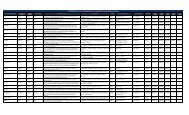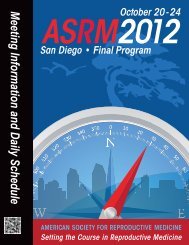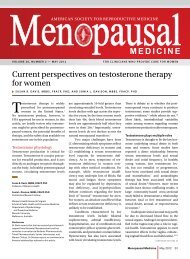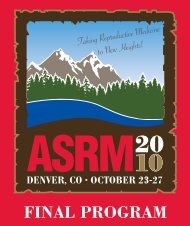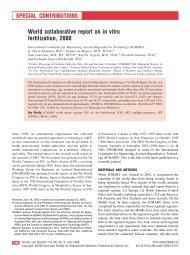scientific program • symposia - American Society for Reproductive ...
scientific program • symposia - American Society for Reproductive ...
scientific program • symposia - American Society for Reproductive ...
You also want an ePaper? Increase the reach of your titles
YUMPU automatically turns print PDFs into web optimized ePapers that Google loves.
SCIENTIFIC PROGRAM <strong>•</strong> INTERACTIVE SESSIONS<br />
Monday, October 17, 2011 1:15 pm – 2:15 pm<br />
Interactive Session<br />
FIBROIDS AND ART OUTCOME: TO INTERFERE OR NOT TO<br />
INTERFERE. AN INTERACTIVE DEBATE.<br />
Joint Session presented by the Fibroid Special Interest Group and the<br />
<strong>Society</strong> <strong>for</strong> Assisted <strong>Reproductive</strong> Technology<br />
Ayman Al-Hendy, M.D., Ph.D. (Chair)<br />
Meharry Medical College<br />
James H. Segars, M.D.<br />
Eunice Kennedy Shriver National Institute of Child Health and Human<br />
Development<br />
James M. Goldfarb, M.B.A., M.D.<br />
University Hospitals Case Medical Center<br />
Needs Assessment and Description<br />
Uterine leiomyomata (fibroids) are the most common<br />
pelvic tumors, and their effect on IVF outcome is not fully<br />
understood. Leiomyoma lesions that protrude or distort<br />
the uterine cavity have been shown to negatively affect<br />
implantation and pregnancy rates. However, studies<br />
addressing the effect on IVF outcome of intramural<br />
leiomyomata and other lesions not distorting the uterine<br />
cavity have yielded conflicting results. Debates and<br />
disagreement in the ART community are still running high<br />
regarding the need <strong>for</strong> myomectomy <strong>for</strong> submucosal<br />
or intramural leiomyomata prior to IVF and other ART<br />
procedures.<br />
Monday, October 17, 2011 1:15 pm – 2:15 pm<br />
Interactive Session<br />
OVARIAN TISSUE CRYOPRESERVATION: TRANSPLANTATION VS.<br />
IN VITRO MATURATION. AN INTERACTIVE DEBATE.<br />
Presented by the Fertility Preservation Special Interest Group<br />
Karine Chung, M.D. (Chair)<br />
USC Fertility<br />
Teresa K. Woodruff, Ph.D.<br />
Northwestern University<br />
Dror Meirow, M.D.<br />
Sheba Medical Center<br />
Needs Assessment and Description<br />
According to the guidelines of the <strong>American</strong> <strong>Society</strong> <strong>for</strong><br />
Clinical Oncology, patients who are facing potentially<br />
sterilizing cancer treatments should be counseled about<br />
the potential <strong>for</strong> infertility and should be offered options<br />
<strong>for</strong> fertility preservation. For female patients whose<br />
cancer therapy cannot be delayed to allow time <strong>for</strong><br />
in vitro fertilization, ovarian tissue cryopreservation is an<br />
option. Clinical experience is increasing and outcomes<br />
are improving, but optimal strategies <strong>for</strong> utilizing the<br />
ovarian tissue remain uncertain. There are no clinical trials<br />
comparing and contrasting the approaches of ovarian<br />
tissue transplantation versus in vitro follicle maturation. To<br />
provide optimal care <strong>for</strong> patients, clinicians require up-todate<br />
in<strong>for</strong>mation in order to appropriately counsel patients<br />
presenting <strong>for</strong> ovarian tissue cryopreservation as a potential<br />
means of fertility preservation.<br />
Room 224 E/F<br />
Room 231 A/C<br />
84<br />
Learning Objectives<br />
At the conclusion of this session, participants should be able<br />
to:<br />
1. Describe the impact of the location of uterine<br />
leiomyomata on IVF outcome.<br />
2. Examine the role of myomectomy in patients undergoing<br />
IVF.<br />
3. Identify the best approach <strong>for</strong> myomectomy in patients<br />
undergoing IVF (hysteroscopic, open, laparoscopic, or<br />
robotics).<br />
ACGME COMPETENCY<br />
Medical Knowledge<br />
Patient Care<br />
TEST QUESTION:<br />
A 30-year-old woman and her 34-year-old husband, who<br />
have never achieved pregnancy, have been advised to<br />
undergo IVF-ET. She was diagnosed to have a non-cavitydistorting<br />
intramural fibroid.<br />
After participating in this session, I will do the following:<br />
A. Reassure the couple and advise them to proceed with<br />
IVF-ET.<br />
B. Advise the couple to have minimally invasive<br />
myomectomy either through traditional laparoscopy or<br />
robotic surgery.<br />
C. Advise them to proceed with IVF first, then, if that fails,<br />
proceed with myomectomy.<br />
D. Not applicable to my area of practice.<br />
Learning Objectives<br />
At the conclusion of this session, participants should be able<br />
to:<br />
1. Summarize the current status and applicability of ovarian<br />
tissue cryopreservation <strong>for</strong> fertility preservation in female<br />
cancer patients.<br />
2. Discuss current methods of ovarian tissue freezing.<br />
3. List 3 advantages and 3 disadvantages of both ovarian<br />
tissue transplantation and in vitro follicle maturation in<br />
patients requesting fertility preservation<br />
ACGME COMPETENCY<br />
Medical Knowledge<br />
Patient Care<br />
TEST QUESTION:<br />
A 26-year-old recently married woman with acute<br />
lymphoblastic leukemia is referred by her oncologist <strong>for</strong><br />
fertility preservation. She is scheduled to start combination<br />
chemotherapy in less than 1 week. After participating in this<br />
session, in my practice I will offer this patient:<br />
A. IVF with embryo cryopreservation.<br />
B. GnRH analogue prior to and during chemotherapy.<br />
C. Laparoscopy with oophorectomy and ovarian tissue<br />
freezing.<br />
D. Not applicable to my area of practice.



